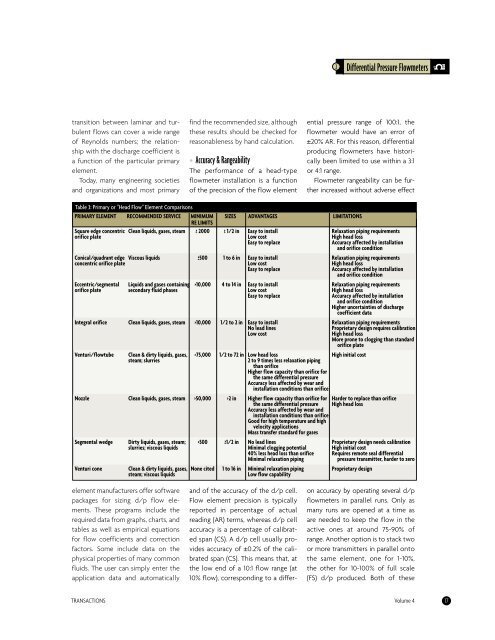flow and level measurement - Omega Engineering
flow and level measurement - Omega Engineering
flow and level measurement - Omega Engineering
You also want an ePaper? Increase the reach of your titles
YUMPU automatically turns print PDFs into web optimized ePapers that Google loves.
transition between laminar <strong>and</strong> turbulent<br />
<strong>flow</strong>s can cover a wide range<br />
of Reynolds numbers; the relationship<br />
with the discharge coefficient is<br />
a function of the particular primary<br />
element.<br />
Today, many engineering societies<br />
<strong>and</strong> organizations <strong>and</strong> most primary<br />
element manufacturers offer software<br />
packages for sizing d/p <strong>flow</strong> elements.<br />
These programs include the<br />
required data from graphs, charts, <strong>and</strong><br />
tables as well as empirical equations<br />
for <strong>flow</strong> coefficients <strong>and</strong> correction<br />
factors. Some include data on the<br />
physical properties of many common<br />
fluids. The user can simply enter the<br />
application data <strong>and</strong> automatically<br />
find the recommended size, although<br />
these results should be checked for<br />
reasonableness by h<strong>and</strong> calculation.<br />
• Accuracy & Rangeability<br />
The performance of a head-type<br />
<strong>flow</strong>meter installation is a function<br />
of the precision of the <strong>flow</strong> element<br />
<strong>and</strong> of the accuracy of the d/p cell.<br />
Flow element precision is typically<br />
reported in percentage of actual<br />
reading (AR) terms, whereas d/p cell<br />
accuracy is a percentage of calibrated<br />
span (CS). A d/p cell usually provides<br />
accuracy of ±0.2% of the calibrated<br />
span (CS). This means that, at<br />
the low end of a 10:1 <strong>flow</strong> range (at<br />
10% <strong>flow</strong>), corresponding to a differ-<br />
2 Differential Pressure Flowmeters<br />
ential pressure range of 100:1, the<br />
<strong>flow</strong>meter would have an error of<br />
±20% AR. For this reason, differential<br />
producing <strong>flow</strong>meters have historically<br />
been limited to use within a 3:1<br />
or 4:1 range.<br />
Flowmeter rangeability can be further<br />
increased without adverse effect<br />
Table 3: Primary or "Head Flow" Element Comparisons<br />
PRIMARY ELEMENT RECOMMENDED SERVICE MINIMUM<br />
RE LIMITS<br />
SIZES ADVANTAGES LIMITATIONS<br />
Square edge concentric<br />
orifice plate<br />
Clean liquids, gases, steam ≥ 2000 ≥ 1/2 in Easy to install<br />
Low cost<br />
Easy to replace<br />
Relaxation piping requirements<br />
High head loss<br />
Accuracy affected by installation<br />
<strong>and</strong> orifice condition<br />
Conical/quadrant edge Viscous liquids<br />
concentric orifice plate<br />
≥500 1 to 6 in Easy to install<br />
Low cost<br />
Easy to replace<br />
Relaxation piping requirements<br />
High head loss<br />
Accuracy affected by installation<br />
<strong>and</strong> orifice condition<br />
Eccentric/segmental<br />
orifice plate<br />
Liquids <strong>and</strong> gases containing<br />
secondary fluid phases<br />
>10,000 4 to 14 in Easy to install<br />
Low cost<br />
Easy to replace<br />
Relaxation piping requirements<br />
High head loss<br />
Accuracy affected by installation<br />
<strong>and</strong> orifice condition<br />
Higher uncertainties of discharge<br />
coefficient data<br />
Integral orifice Clean liquids, gases, steam >10,000 1/2 to 2 in Easy to install<br />
No lead lines<br />
Low cost<br />
Relaxation piping requirements<br />
Proprietary design requires calibration<br />
High head loss<br />
More prone to clogging than st<strong>and</strong>ard<br />
orifice plate<br />
Venturi/<strong>flow</strong>tube Clean & dirty liquids, gases,<br />
steam; slurries<br />
>75,000 1/2 to 72 in Low head loss<br />
2 to 9 times less relaxation piping<br />
than orifice<br />
Higher <strong>flow</strong> capacity than orifice for<br />
the same differential pressure<br />
Accuracy less affected by wear <strong>and</strong><br />
installation conditions than orifice<br />
High initial cost<br />
Nozzle<br />
Clean liquids, gases, steam >50,000 >2 in Higher <strong>flow</strong> capacity than orifice for<br />
the same differential pressure<br />
Accuracy less affected by wear <strong>and</strong><br />
installation conditions than orifice<br />
Good for high temperature <strong>and</strong> high<br />
velocity applications<br />
Mass transfer st<strong>and</strong>ard for gases<br />
Harder to replace than orifice<br />
High head loss<br />
Segmental wedge Dirty liquids, gases, steam;<br />
slurries; viscous liquids<br />
>500 ≥1/2 in No lead lines<br />
Minimal clogging potential<br />
40% less head loss than orifice<br />
Minimal relaxation piping<br />
Proprietary design needs calibration<br />
High initial cost<br />
Requires remote seal differential<br />
pressure transmitter, harder to zero<br />
Venturi cone<br />
Clean & dirty liquids, gases,<br />
steam; viscous liquids<br />
None cited 1 to 16 in Minimal relaxation piping<br />
Low <strong>flow</strong> capability<br />
Proprietary design<br />
on accuracy by operating several d/p<br />
<strong>flow</strong>meters in parallel runs. Only as<br />
many runs are opened at a time as<br />
are needed to keep the <strong>flow</strong> in the<br />
active ones at around 75-90% of<br />
range. Another option is to stack two<br />
or more transmitters in parallel onto<br />
the same element, one for 1-10%,<br />
the other for 10-100% of full scale<br />
(FS) d/p produced. Both of these<br />
TRANSACTIONS Volume 4 17

















